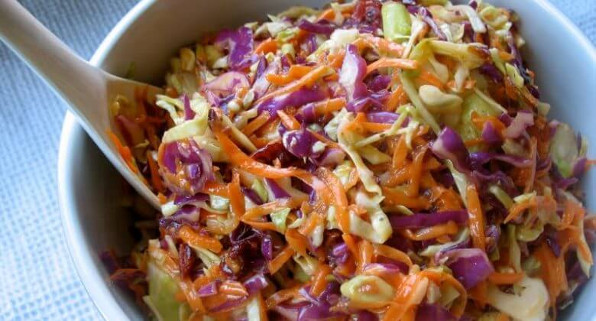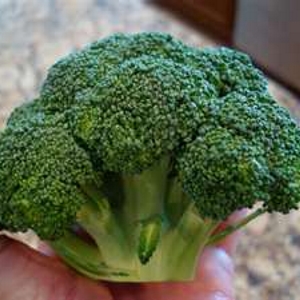This post is really about two issues: top picks among the best nature has to offer in nutrition-dense foods, and how to afford them on your stressed-out food budget. Yes, you can feed your family healthier, more nutritious food!
 My Confetti Cole Slaw: With a sweet, German-style vinaigrette,
My Confetti Cole Slaw: With a sweet, German-style vinaigrette,
2 colours of cabbage, carrot and slivered onions (optional).
Some folks also add inexpensive, sweet grated apple…
As you might have already guessed, the foods I’m about to showcase are all fresh veggies. Too rich for your wallet, you say? Not if you embrace my strategy for including them in your family’s regular dining routine…
Here they are
I tripped over a really good post about nutrition-rich foods the other day when I was looking for something else altogether. Great discoveries are made that way more often than you might think!
Nevertheless… Here are my picks from among the 19 selections in the Good Housekeeping (GH) post…
Plantain
It’s a Caribbean staple. And is eaten, in various prepartions, at all meals. It’s starchy and firm, rather than sweet and mushy. And you’ll find gazillions of recipes using Plantain via Google. They can be consumed green or ripe. Great value for your buck!
Cabbage
From cole slaw to kimchee, it’s a versatile member of the cruciferous vegetable family. There are many varieties and many, many ways to prepare them. A little goes a long way – it’s filling. Cabbage is physically dense as well as being a great source of vitamins, minerals and fibre.
Garlic
It’s usually considered a flavouring addition to cooked dishes. But it’s a full-fledged member of the allium family, packing vitamins and fiber. As well as antibacterial and anti-inflammatory properties.
Carrots
Surprised? They may not let you see in the dark, but they do pack a load of beta-carotene, which your body converts to vitamin K – and that’s really good for your eyes. The GH post noes: “Carrots can add crunch, flavor and vibrant color to your meals and snacks. Add shredded or sautéed carrots to marinara sauce. Or enjoy these root veggies raw, shredded in salads, or blended in a healthy smoothie.“
Broccoli
Forget, for a moment, all the anecdotes, mainly from kids and old men, about Broccoli being yucky. It’s really a great veggie, and it tastes pretty good when cooked properly. If you find its natural bitter edge nasty, just avoid it raw, in salads and crudité platters. Broccoli is another cruciferous veggie (like cabbage) that’s high in micronutrients, including vitamins C, A and K. In fact, one half cup of raw, chopped broccoli provides 43 percent of the daily value of vitamin C.
Mushrooms
These friendly fungi often get short shrift on lists of nutrition-dense foods. But they are, in fact, rich in B vitamins niacin, riboflavin, and pantothenic acid. They also deliver bioactive compounds that can support cognition, heart health and your immune system.
Sweet Bell Peppers
Great, unique flavour. Great Crunchy texture. And an honoured place in cuisines from Marrakesh to Minneapolis. But sweet peppers – whether green, red, yellow or purple – are excellent sources of vitamins A and C, as well as potassium and fiber. They also deliver anti-inflammatory compounds such as phenols and flavonoids.
Onions
The lowly onion… Not so lowly in nutrition terms! Another allium family member. And recent research suggests that alliums are rich in compounds that may fight cancer, as well as prebiotics that can help improve gut health and digestion.
Tomatoes
Yes, even tomatoes… Always available, always uniquely flavourful and colourful! And a great source of lycopene which may reduce your risk for cardiovascular disease. Also a great source of anti-oxidants and compounds that may reduce your risk of cancer.
How to buy them..
Don’t think, for a moment, that you have to buy all of the above every week. I usually choose 4 complementary picks from my list, and plan dishes or whole meals around them. I may repeat a pick the next week. But the other three will be different. Naturally leading to different dishes, and different meals.
Don’t buy the most expensive picks from the list. They might be on sale next week. And don’t buy multi-packs. You’ll spend too much on one item, and some of the food may spoil before you can use it. The produce department is great, in that you can usually choose one or two nice examples of any veggie you want. That’s probably all you’ll need for your meal plan!
Stay on script. Don’t use your fresh veggies for dishes other than those you planned. As in, resist the urge to cut a slice of tomato for that casual luncheon sandwich. You might come up short for your planned meals!
DO serve generous portions of veggies such as cabbage and broccoli. If folks complain about the ‘yuck’ factor, add butter or cheese sauce, respectively!
~ Maggie J.

